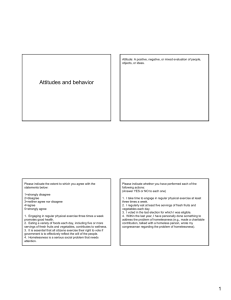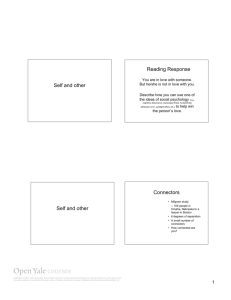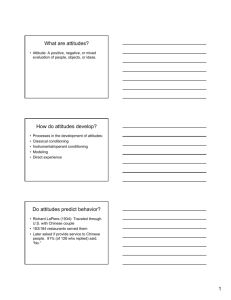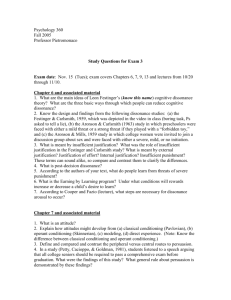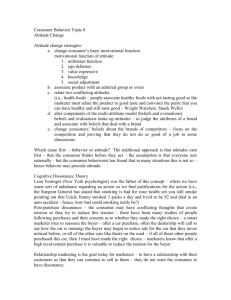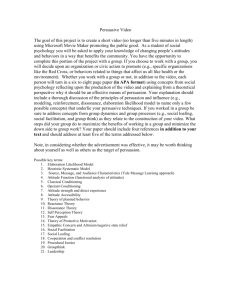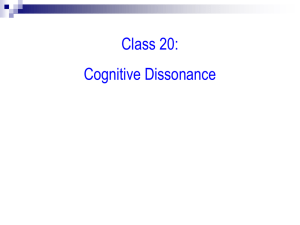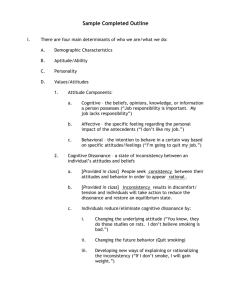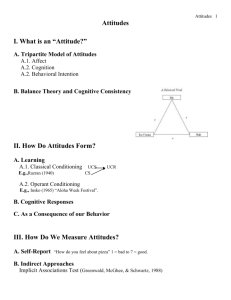Social Psychology
advertisement
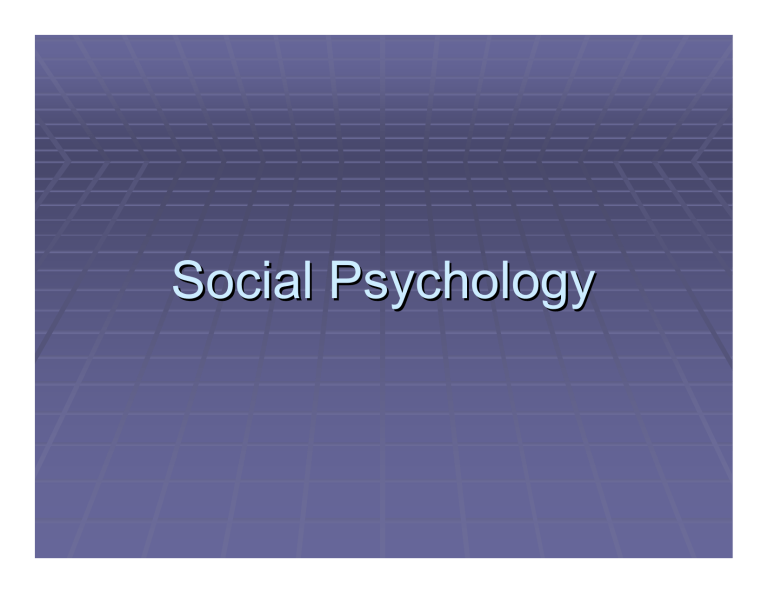
Social Psychology Cognitive Dissonance Theory Consider the following situation: You bring students into the lab and ask them to work on a boring and repetitive task for an hour As they’re leaving, Ss are asked to tell the next subject coming in that the task was very interesting Some Ss were paid $1 to do this, others were paid $20 to do this Afterwards Ss were asked to rate how much they actually enjoyed the task on a -5 to +5 scale Also rated how interested they were in participating again Three conditions: $1 group, $20 group, & a control group who were not asked to lie to the next subject, but were simply asked how much they liked the task and how interested they were in participating again Which group do you think said they enjoyed the task more? Would be more interested in participating again? Mean rating of task enjoyment $1 $20 Control +1.35 -0.05 -0.45 Same pattern for willingness to participate again Insufficient Justification Effect (Festinger & Carlsmith, 1959) 1.5 1.35 1.2 Rating 1 0.5 Control $1 $20 0 -0.05 -0.25 -0.5 -0.45 -0.62 -1 Enjoy? Participate again? Festinger’s Cognitive Dissonance Theory This was a classic experiment carried out by Festinger & Carlsmith It generated a huge amount of interest and research because Festinger & Carlsmith correctly predicted the counterintuitive pattern found on the basis of Festinger’s new theory called cognitive dissonance theory Furthermore, it dealt with a very important aspect of human social interaction: attitude change Cognitive Dissonance Theory Basic idea is that people are always comparing their cognitions (attitudes, knowledge, beliefs) to one another Cognitions can be related to one another in one of three ways Consonant: When you have two cognitions that fit together or are harmonious, you feel satisfied (consonance), e.g., ‘Smoking causes lung cancer’ & ‘I don’t smoke’ Dissonant: When you have two cognitions that don’t fit together seem contradictory, you feel uncomfortable (dissonance), e.g., ‘Smoking causes lung cancer’ & ‘I smoke 2 packs a day’ Irrelevant: Two cognitions may be irrelevant, e.g., ‘It’s raining outside’ & ‘It’s 3000 miles from Paris to New York’ Cognitive Dissonance Cognitive dissonance – An unpleasant internal state of tension that results when people notice inconsistencies in their cognitions (about attitudes, beliefs and behaviors) The most common source: Attitude-behavior discrepancies People are motivated to reduce dissonance Three ways to reduce dissonance Change one of the cognitions (either the attitude or behavior) Stop smoking Change my belief that smoking causes lung cancer Add more consonant cognitions I’m addicted so I can’t quit I enjoy smoking I use filters that trap all the bad stuff Reduce the importance of relevant cognitions Everybody’s got to die sometime How Does Dissonance Theory Explain the Festinger & Carlsmith Results? 1.5 1.35 1.2 Rating 1 0.5 Control $1 $20 0 -0.05 -0.25 -0.5 -0.45 -0.62 -1 Enjoy? Participate again? Dissonance Theory Explanation of the Festinger & Carlsmith Results What produced the dissonance? Attitude-discrepant behavior: The task was boring; I told someone the task was interesting Which of the 3 conditions had the most dissonance to be reduced? The $1 condition $20 is a cognition that’s highly consonant with telling the person the task was interesting Ss in the control condition never engaged in attitudediscrepant behavior Consequently, the most attitude change would be expected in the $1 condition Insufficient Justification Effect Replication In Cohen’s study he went into dorms at Yale after a student-police altercation and had Ss write pro-police essays for varying amounts of money After writing the essay Ss were asked to rate their true attitude toward the police (high numbers = more positive attitude) $.50 $1 $5 $10 Control Attitude toward police 4.54 3.47 3.08 2.32 2.70 When Prophecy Fails Leon Festinger, Henry Riecken, & Stanley Schachter September 1954, Lake City Herald headline... PROPHECY FROM PLANET. CLARION CALL TO CITY: FLEE THAT FLOOD, IT’LL SWAMP US ON DEC. 21, OUTER SPACE TELLS SUBURBANITE. The Story of Mrs. Keech Good example of the technique of participant observation Dissonance Theory Predictions Festinger, Riecken, & Schacter predicted that when the catastrophe failed to materialize, group members would experience high dissonance They predicted dissonance reduction by adding consonant cognitions would be the easiest way to reduce dissonance Hence, they expected an increase in efforts to recruit new members Forbidden Toy Paradigm (Aronson & Carlsmith, 1963) Child shown 5 toys varying in attractiveness Child asked to rank toys in order of liking 2nd ranked toy placed on table 3 experimental conditions; in all 3 experimenter says she has to leave for awhile No threat (control): Places toy in sight but out of reach Mild threat: “I don’t want you to play with the ___. If you play with it, I would be annoyed.” Severe threat: “I don’t want you to play with the ___. If you play with it, I would be very angry.” When experimenter returns, the child is asked to rank the toys again Results and Analysis Interest was in changes in attitude toward (i.e., attractiveness of) the forbidden toy Condition Mild Threat Severe Threat No Threat Ranking of Forbidden Toy Increased Same Decreased 4 10 8 14 8 0 7 4 0 What would dissonance theory predict? What produces the dissonance here? What’s the attitude and the attitudediscrepant behavior? In which condition would the dissonance to be reduced be greatest? How could that dissonance be reduced? Mild threat: attitude-behavior inconsistency dissonance effort to reduce alter attitude Experimenters returned 40 days later and had kids rerank the toys: Changes in attractiveness of the forbidden toy persisted—thus, it was not a temporary attitude change Implications of Dissonance Theory Interpretation of Forbidden Toy Paradigm To achieve maximum attitude change, the person needs to engage in attitude-discrepant behavior This should be accomplished with as mild a threat as possible so that dissonance is not reduced by the threat and must be reduced by attitude change instead Insufficient Justification Effect Experiments and Alternative Explanations Many studies were carried out looking at the insufficient justification effect and the conditions under which it occurred The effect turned out to be easy to replicate The conditions under which it occurred were generally consistent with a dissonance theory explanation Dissonance theory, however, wasn’t the only explanation developed to account for the results from insufficient justification experiments Dissonance theory premise: Attitude change is driven by an aversive arousal state (dissonance, an unpleasant state of tension) Darryl Bem, an attribution theorist, suggested an alternative interpretation Attribution theorists study how people think about the causes their own and others’ behavior Bem’s Self Perception Theory People observe their OWN behavior and the context in which it occurs People use their observations of their own behavior to draw inferences about what their attitudes must be Example: Do you like whole wheat bread? Well, I guess I must since I buy it every time I go to the store Assuming that people do this provides an alternative explanation for the insufficient justification effect—one that doesn’t require dissonance (unpleasant state of tension) to drive the attitude change Bem’s explanation of the Festinger & Carlsmith result postulated that when Ss were asked how much they enjoyed the task they simply looked at their own behavior (coldly, rationally—no tension) $20: infer behavior due to money $1: infer behavior due to attitude Critical features of self perception: Made same predictions as dissonance theory But more parsimonious; therefore, in the absence of better evidence, it would be preferred Seemed to apply to all experiments to date Bem’s Replication of Cohen’s Study To support his argument, Bem replicated Cohen’s pro-police essay study, but without having his subjects engage in attitude-discrepant behavior He asked his subjects simply to read a pro-police essay and told them how much the writer had been paid to write the essay (using the same monetary conditions Cohen had used) Then he asked them to make a judgment about the essay writer’s true attitude toward the police He found the same pattern that Cohen did and argued that dissonance reduction could not be the explanation in his later study because subjects never engaged in any attitude-discrepant behavior, so no dissonance was ever aroused Thus, he argued postulating the need to reduce an unpleasant state of psychological tension is unnecessary to account for the insufficient justification effect This controversy between self perception theory and dissonance theory generated a huge amount of research It turned out that each theory accounted for some results but not all, so both effects appear to be operative in the insufficient justification effect Additional Implications of Self Perception Theory Self perception theory is a form of attribution theory which commonly makes a distinction between internal (dispositional) and external (situational) causes of behavior Self perception theorists argue that when people see their own behavior in a task as internally caused they attribute their behavior to their own intrinsic interest in the task (intrinsic motivation) When people see their behavior in a task as resulting from external inducements they attribute their behavior to those extrinsic inducements (extrinsic motivation) By varying levels of intrinsic and extrinsic rewards associated with a task one arrives at differing predicted self perceptions of motivation Insufficient and Oversufficient Justification Effects Level of Extrinsic Reward Low Low High Insufficient Justification (Unstable perception) Stable perception of extrinsic motivation Stable perception of intrinsic motivation Oversufficient Justification (Unstable perception) Level of Intrinsic Reward High Oversufficient Justification Effect Both dissonance theory and self perception theory predict the insufficient justification effect, namely, that individuals in an insufficient justification situation will be motivated to change their attitude toward the task and see it as more intrinsically interesting Only self perception theory predicts an oversufficient justification effect, namely, that if high extrinsic reward is added to an already intrinsically interesting task, interest in the task will be undermined Evidence for an Oversufficient Justification Effect ‘Magic Marker’ study (Lepper, Greene, & Nisbett, 1973) Observed that 3-5 year old kids love playing with magic markers All kids were told they could play with magic markers for awhile, but kids were randomly assigned to one of 3 groups Expected Reward (received the ‘Good Player Award’) Unexpected Reward (unexpectedly received ‘Good Player Award’ at end of time) No Reward Several weeks later, kids’ regular teacher brought out magic markers along with other play materials Experimenters observed how much time kids spent playing with magic markers when they could play with any of the materials Also had judges (blind to condition) rate the quality of drawings made Intrinsic interest in drawing with magic markers AFTER award received (or not received) was operationally defined as the percent of free-choice time spent drawing with the markers Magic Marker Study % Time Played with Magic Markers Lepper, Greene, & Nisbett (1975) 20 18.1 18 16.7 16 14 12 10 8.6 8 6 4 2 0 Expected Reward Unexpected Reward No Reward Note. Judges also rated the drawings to be of poorer quality in the Expected Reward condition than in the other conditions Implications Should we never reward children? Extrinsic rewards probably don’t undermine interest for behaviors that aren’t intrinsically rewarding Tangible awards should be just large enough to encourage activity – decrease in intrinsic motivation is inversely related to extrinsic reward Intangible rewards (verbal praise) probably helpful all the time Attribution Theory Attribution theory has been a major area of study in social psychology Attribution theorists study how people think about the causes their own and others’ behavior and commonly make a distinction between internal (dispositional) and external (situational) causes of behavior Attribution theory tries to delineate the conditions that distinguish when people will attribute behavior to internal causes vs external causes One bias that people seem to exhibit in their attributions is so consistent that it has been called the Fundamental Attribution Error Fundamental Attribution Error The tendency to overestimate the importance of personal dispositions (internal attributions) in determining behavior and underestimate the importance of situations (external attributions) We have a preference for internal attributions Actor-Observer Effect The Fundamental Attribution Error is stronger when perceiving others than when perceiving the self We make more internal/dispositional attributions of others and more situational attributions of self The Fundamental Attribution Error probably accounts for the ‘surprisingness’ of many of the classic findings in social psychology Stanley Milgram’s (1963) Obedience Studies Purpose of studies: Find out the conditions under which people would be willing to harm others simply in obedience to an authority figure Impetus was the observation that in WWII many in Germany used obedience to authority as a justification for inhumane behavior Milgram brought 2 subjects into lab, however, only 1 was a real subject; the other was a confederate A rigged coin flip always assigned the real subject to be the ‘Teacher,’ the confederate the ‘Learner’ Subject (teacher) was instructed to administer electric shocks for wrong answers Shocks would intensify with successive wrong answers (15 - 450 volts) Milgram’s Obedience Experiments Both teacher and learner were initially hooked up to shock generator to feel the shock In the main study, teachers then went to another room with the experimenter and communicated with the learner via intercom Some studies varied the proximity between teacher and learner One condition was the Touch-Proximity condition seen here Milgram’s Shock Generator Learner’s Schedule of Protests 1 120: “ugh! Hey, this really hurts.” 150: “ugh!!! Experimenter! That’s all. Get me out of here. I told you I had heart trouble. My heart’s starting to bother me now. Get me out of here, please. My heart’s starting to bother me. I refuse to go on. Let me out.” 195: similar to 150 210: “Ugh!! Experimenter! Get me out of here. I’ve had enough. I won’t be in the experiment any more.” 270: (agonized scream) “Let me out of here (x6)” 285: (agonized scream) Learner’s Schedule of Protests 2 300: (agonized scream) “I absolutely refuse to answer any more. Get me out of here. You can’t hold me here…” 315: (intensely agonized scream) “I told you I refuse to answer. I’m no longer part of this experiment.” 330: (intense and prolonged agonized scream) “Let me out of here (x2). My heart’s bothering me …. (hysterically) Let me out of here (x2). You have no right to hold me here. Let me out! (x6).” After 330: silence, refuses to answer word-pair questions Experimenter’s Schedule of Prods Prod 1: “Please continue” or “Please go on” Prod 2: “The experiment requires that you continue” Prod 3: “It is absolutely essential that you continue” Prod 4: “You have no other choice, you must go on” Results of Milgram’s Studies of Obedience Copyright © Allyn and Bacon Surprising Results Why do Milgram’s results seem so surprising? Probably in part because we tend to make the Fundamental Attribution Error The situation was extremely powerful in Milgram’s studies The Milgram Controversy Milgram’s study was widely criticized and led to a great deal of concern for the naive subject. Soon after, human subjects committees were developed to review all social science research proposals. The human subject committee requires: 1) Informed consent 2) Careful (and infrequent) use of deception 3) Thorough debriefing Asch’s Conformity Studies Line-Judgment Task Participants were asked to indicate which of three lines best matched a standard line after a unanimous group gives wrong answer (see Figure) Asch’s Conformity Results Subjects conformed to false majority on 37% of critical trials 76% of subjects conformed at least once (much variability) As group size increased (up to about 5 or 6) conformity increased, after that group size had little effect When given an ally (even if they disagreed with subject), conformity decreased to 8% When responses made privately, almost no one conformed Again, surprisingness of results probably due in part to Fundamental Attribution Error Altruism or Helping Behavior In 1964 Kitty Genovese (New York City ) was sexually assaulted and stabbed eight times. Overall the attack lasted for over 35 minutes The killer was scared off twice by Kitty's screams and struggles ("Oh my God, he stabbed me! Please help me! Please help me!"), and by the voices and lights of the 38 people who watched from their windows. As no one intervened, however, he returned each time to attack again. No one even called the police during the attack. Only 1 person belatedly called the police after the attack was over When apartment tenants were interviewed later they said they saw the attack but were afraid to ‘get involved’ Work on altruism is purported to have started with the breaking of this story. Two social psychologists (Latane and Darley) read the reports of this horrific attack and started to consider why, despite the length and severity of the attack, no one even called the police Darley & Latane’s work suggested that problem here was probably one they called diffusion of responsibility Bystander Intervention Research: Diffusion of Responsibility Darley & Latane (1968) – epileptic seizure study % by end of seizure 85 % in 6 minutes 100 3 [subject, victim, 1 other] 62 85 6 [subject, victim, 4 others] 31 62 Group size 2 [subject, victim] Bystander Intervention Research: Noticing the Situation Darley & Batson (1973) “Good Samaritan” study Princeton Theology Seminary students were on their way to give a sermon about “The Good Samaritan” Subjects were deliberately made to be early, ontime, or late On their way through an alley, the seminary students found a man slumped in a doorway, coughing and groaning What do you think they did? Bystander Intervention Research: Noticing the Situation Darley & Batson (1973) – Good Samaritan 1. Late 2. On Time % helping 10 65 Question: Did being late simply make the students less caring about the well-being of the person needing help? Probably not the entire explanation students in a rush were preoccupied didn’t pick up on all the relevant social cues didn’t interpret the man on the ground as someone potentially in need of help Bystander Intervention Research: Situational Ambiguity Latane & Darley (1968) – smoke filled room % help (2 min.) % help (6 min). 1. Alone 2. Two others 50 12 73 38 Question: Why does having other people around make such a difference? Answer: Pluralistic Ignorance If there is any ambiguity, people look to others to see if they are reacting Unfortunately, everyone else does the same thing, so no one reacts Steps Leading to Intervention Awareness Definition of emergency Personal responsibility Decide how to intervene Carry out intervention
